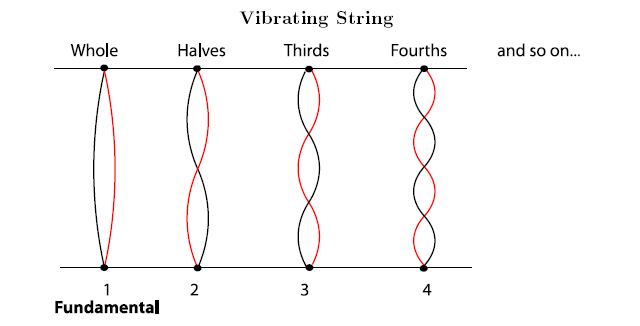Most musical notes are sounds that have a particular pitch. The pitch depends on the main frequency of the sound; the higher the frequency, and shorter the wavelength, of the sound waves, the higher the pitch is. But musical sounds don't have just one frequency. Sounds that have only one frequency are not very interesting or pretty. They have no more musical color than the beeping of a watch alarm. On the other hand, sounds that have too many frequencies, like the sound of glass breaking or of ocean waves crashing on a beach, may be interesting and even pleasant. But they don't have a particular pitch, so they usually aren't considered musical notes.

When someone plays or sings a musical tone, only a very particular set of frequencies is heard. Each note that comes out of the instrument is actually a smooth mixture of many different pitches. These different pitches are called harmonics, and they are blended together so well that you do not hear them as separate notes at all. Instead, the harmonics give the note its color.
What is the color of a sound? Say an oboe plays a middle C. Then a flute plays the same note at the same dynamic level as the oboe. It is still easy to tell the two notes apart, because an oboe sounds different from a flute. This difference in the sounds is the color, or timbre (pronounced "TAM-ber") of the notes. Like a color you see, the color of a sound can be bright and bold or deep and rich. It can be heavy, light, dark, thin, smooth, murky, or clear. Some other words that musicians use to describe the timbre of a sound are: reedy, brassy, piercing, mellow, hollow, focussed, transparent, breathy (pronounced BRETH-ee) or full. Listen to recordings of a violin and a viola. Although these instruments are quite similar, the viola has a noticeably "deeper" and the violin a noticeably "brighter" sound that is not simply a matter of the violin playing higher notes. Now listen to the same phrase played by an electric guitar, an acoustic guitar with twelve steel strings and an acoustic guitar with six nylon strings. The words musicians use to describe timbre are somewhat subjective, but most musicians would agree with the statement that, compared with each other, the first sound is mellow, the second bright, and the third rich.
Exercise 3.3:
Listen to recordings of different instruments playing alone or playing very prominently above a group. Some suggestions: an unaccompanied violin or cello sonata, a flute, oboe, trumpet, or horn concerto, Asaian or native American flute music, classical guitar, bagpipes, steel pan drums, panpipes, or organ. For each instrument, what "color" words would you use to describe the timbre of each instrument? Use as many words as you can that seem appropriate, and try to think of some that aren't listed above. Do any of the instruments actually make you think of specific shades of color, like fire-engine red or sky blue?
Where do the harmonics, and the timbre, come from? When a string vibrates, the main pitch you hear is from the vibration of the whole string back and forth. That is the fundamental, or first harmonic. But the string also vibrates in halves, in thirds, fourths, and so on. (Please see Standing Waves and Musical Instruments for more on the physics of how harmonics are produced.) Each of these fractions also produces a harmonic. The string vibrating in halves produces the second harmonic; vibrating in thirds produces the third harmonic, and so on.

A column of air vibrating inside a tube is different from a vibrating string, but the column of air can also vibrate in halves, thirds, fourths, and so on, of the fundamental, so the harmonic series will be the same. So why do different instruments have different timbres? The difference is the relative loudness of all the different harmonics compared to each other. When a clarinet plays a note, perhaps the odd-numbered harmonics are strongest; when a French horn plays the same note, perhaps the fifth and tenth harmonics are the strongest. This is what you hear that allows you to recognize that it is a clarinet or horn that is playing. The relative strength of the harmonics changes from note to note on the same instrument, too; this is the difference you hear between the sound of a clarinet playing low notes and the same clarinet playing high notes.
Note: You will find some more extensive information on instruments and harmonics in Standing Waves and Musical Instruments and Standing Waves and Wind Instruments.
- 4882 reads






